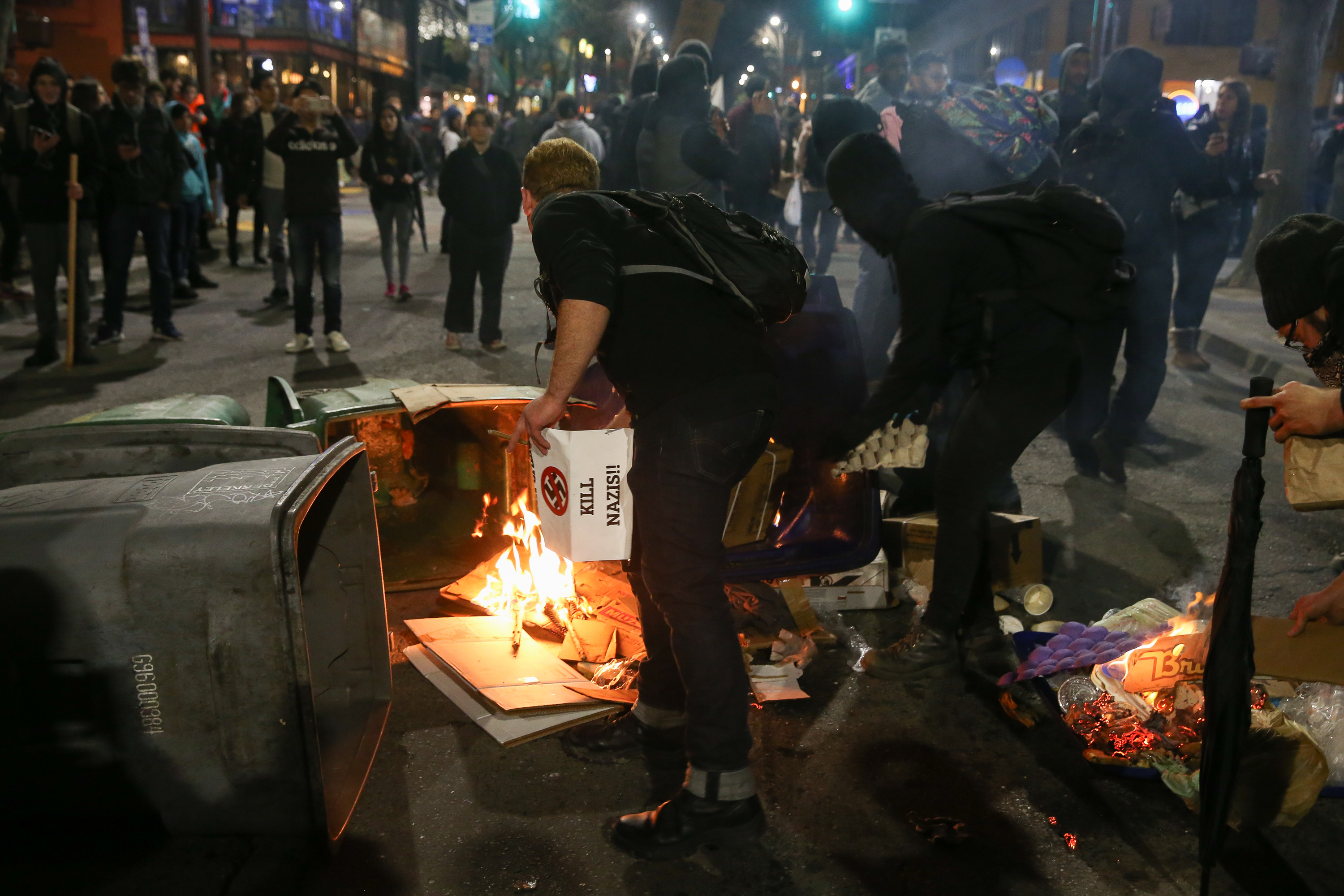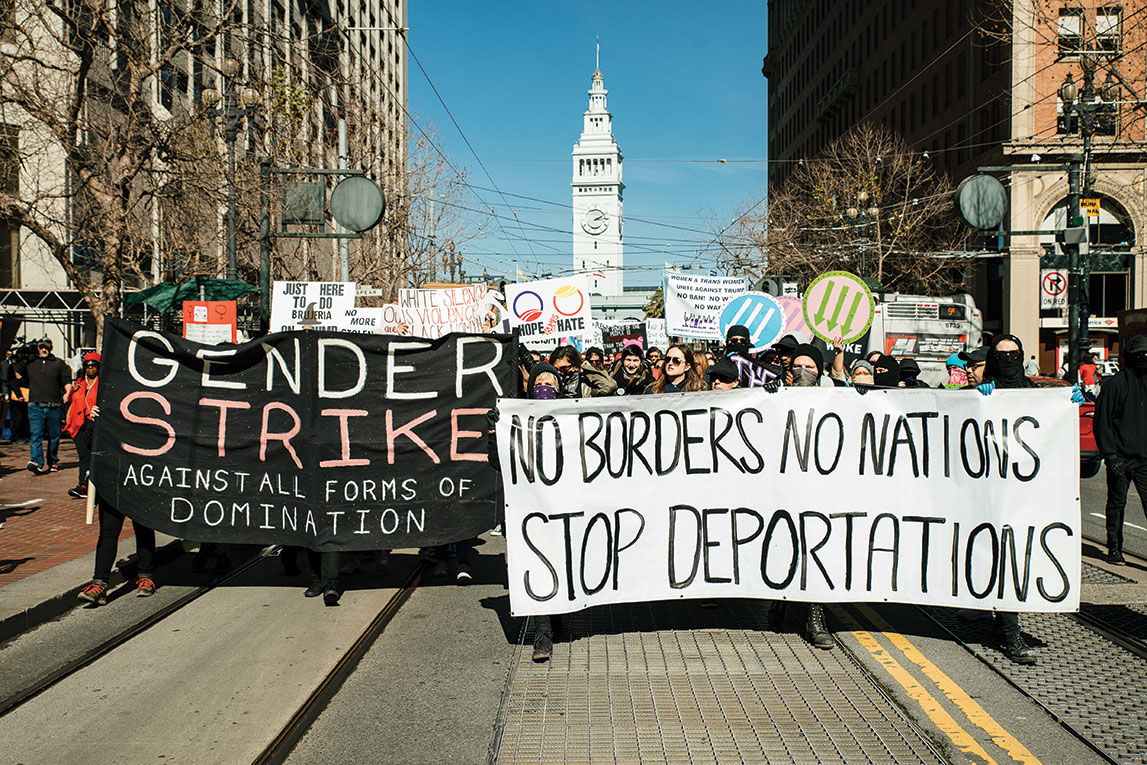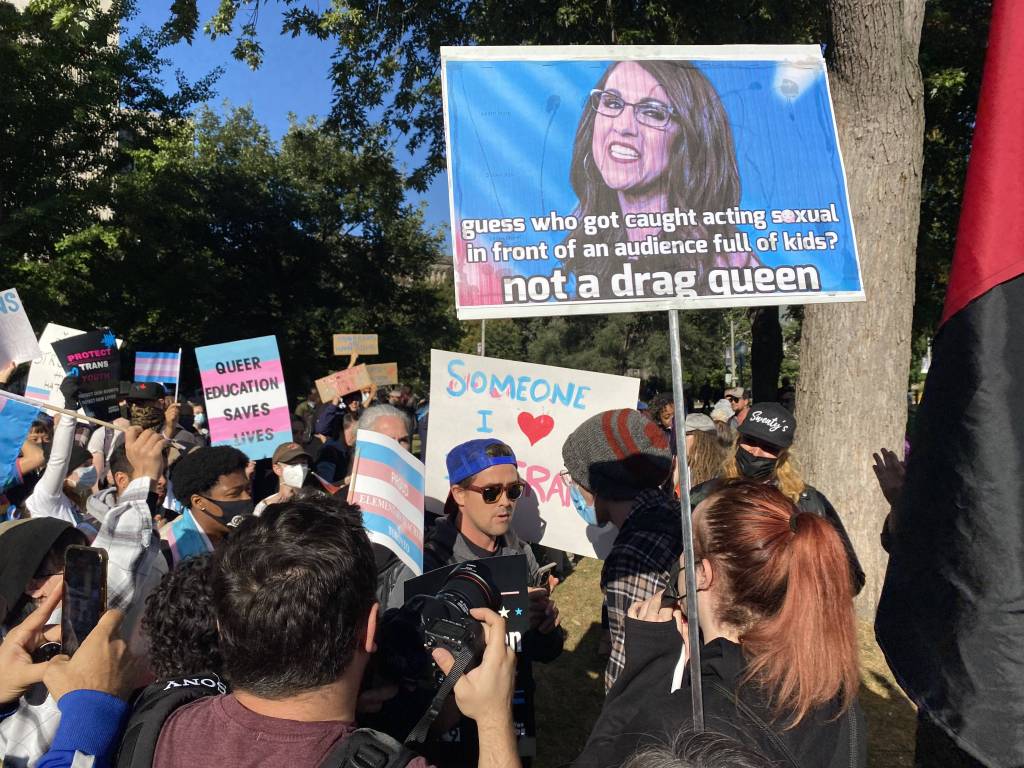This story appears in the May issue of VICE magazine. Click HERE to subscribe.

The Antifa movement has been derided for violent demonstrations. Photo via Elijah Nouvelage/Getty
On the first Saturday of March, just blocks from the Berkeley campus of the University of California, an ultra-nationalistic rally met anti-fascist resistance. It was one of several pro-Trump assemblies around the country that day, and while some in the crowd sported MAKE AMERICA GREAT AGAIN hats and homemade signs arguing against political correctness, some of the 100 or so Trump supporters brandished gas masks on their faces and knives on their waistbands.
Videos by VICE
By 2 PM, there was a crowd of equal or greater size gathered for a counter-demonstration. A young woman with a nose ring carried a RESIST TRUMP sign. Two others, both in dark jeans, hoodies, and bandannas hiding half their faces, held a banner that read ANTI-FASCIST ZONE with three arrows, angled down and to the left, drawn inside the O as a nod to the 1930s anti-Nazi organization the Iron Front. In fact, a sizable portion of the anti-Trump crowd was masked and dressed in black—a sartorial cohesion that read as intimidating but was first and foremost an effort to keep the wearers anonymous, shielded from law enforcement and alt-right doxing.
These demonstrators belonged to the Antifa (short for anti-fascism) movement and clashed with Trump supporters in the middle of the park’s green lawn that day. The skirmish started with shouting matches and quickly escalated to brawls marked by punches and pepper spray. Within a couple hours, knives had allegedly been drawn, blood had been spilled, and ten arrests had been made. Small bonfires made up of MAKE AMERICA GREAT AGAIN hats and American flags littered the lawn. By 5:30 PM, there were still a dozen counter-demonstrators yelling at the dregs of the Trump rally still remaining. “When was America ever great?” a black man with a bit of gray in his hair asked, demanding a response from the last supporter wearing a red cap. But the Trump supporter walked away, never offering an answer.
That same day, bandanna-clad Antifa members protested pro-Trump rallies across the country, but only a few of these demonstrations turned violent. Berkeley’s clash resulted in more arrests than any of the other rallies nationwide, and it marked the third time since last summer that Bay Area Antifa conflicts have made the news. In the wake of the election, the tension felt across the country has a different tenor in the Bay Area, in part because the region has a long history of anarchist organizing dating back to the turn of the 20th century. Following Trump’s victory last November, 7,000 people took to the streets in Oakland with protests lasting for three nights: They lit garbage cans on fire. They threw bricks through car-dealership windows. Thirty of them were arrested.
During the fracas at the rally in March, one of the Antifa demonstrators explained to me the thinking behind their protest. “The point of it is not to give them a platform. You don’t give fascism a platform because once you give it a platform, it becomes normalized,” Devin Lawson* said. He went on to address the violence that had erupted, adding: “Sometimes you have to use direct action to stop it because protesting, signs, yelling is not going to do anything. You have to make them afraid.”
There’s a grassroots punk quality to the way Antifa mobilize underground. And it’s likely that anti-Trump protesters heard about the gathering the same way I did: Through a hotline, you can call for details on music shows at DIY venues and protests coming up in San Francisco, Oakland, and Berkeley. The anarchist-news site Itsgoingdown.org helped facilitate counter-demonstrations by listing the locations and times of all the pro-Trump rallies happening on March 4. Some activists have built peer-to-peer networks as well, passing information between one another via encrypted-texting services like Signal.
The clash in March followed an analogous situation just a month before, during which a similarly outfitted mob of masked protesters shut down Milo Yiannopoulos’s appearance at the Berkeley campus. Yiannopoulos, at the time still yet to be exiled from alt-right circles for his comments on pedophilia, had been invited by the Berkeley College Republicans, but following an article published on Breitbart.com about his campaign against sanctuary campuses, some opponents believed that he intended to out undocumented students during his speech. Networks of anti-fascist organizers mobilized a group of students and nonstudents alike to forcefully deny Yiannopoulos a platform to speak. There was a highly publicized clash between protesters and the police, the talk was canceled, and for days many media outlets sensationalized the skirmish and argued for or against Yiannopoulos’s right to free speech. But to those who participated in the protest, it was a clear victory.
“It was kind of amazing,” Jade*, an 18-year-old Antifa newbie, told me. “There were drums and people yelling, chanting into megaphones. Then the crowd parts, and you see this swarm of dudes dressed in black with flags. They ripped away the barricades, tipped over that generator, and the rest is history.” The protest against Yiannopoulos was the first action she participated in. She was at the Trump counter-demonstration, too. “I’m a queer Jewish trans woman,” she explained. “I have a personal interest in anti-fascism as far as my different intersectionalities.”
Jade didn’t know anything about Antifa when she arrived in the Bay Area less than a year ago. “I just moved here to get away from my parents,” she told me. The string of police shootings of black men that occurred over the past several years encouraged her to become involved with Antifa anarchists. Once she did, she said, she also found a family in the movement.

At a Women’s Day rally in San Francisco, tension between Antifa members and other protesters was palpable. Though they are united against President Trump, some on the left feel Antifa’s reputation for violence is detrimental to the cause. Photo by Ulysses Ortega
Antifa’s roots go back to the early 1930s and the Antifaschistische movement that organized to oppose the rise of Nazism in Germany. The movement was rekindled in the 1980s as skinhead culture rose in popularity and far-right leaders took office throughout the US and Western Europe. Stateside, Anti-Racist Action (ARA) was formed in 1987. “It was a group of anti-racist skinhead punks who got together and created ARA,” Alexander Reid Ross, author of Against the Fascist Creep and adjunct professor at Portland State University, told me. In America, decentralized networks of activists devoted to fighting fascism and racism have adopted the Antifa nomenclature during the last decade. “It was through Rose City Antifa,” Ross said, referring to a Portland group that grew out of the ARA, “that the European and American models were sort of synthesized and the current model of Antifa in the US was developed.”
Taking cues from similar European organizations, American Antifa groups often use “black bloc” tactics, but while that term is sometimes used as interchangeable with “Antifa,” they mean very different things. Black bloc, Ross explained, is “the mobilization of a group wearing black clothing and black bandannas with black hoods or hats to maintain anonymity in the context of some kind of protest.” In the US, he said, Antifa “is an anonymous framework for an organization that gathers intelligence on local fascist groups and either publishes that information for the public, sends that information to other groups who have a vested interest in shutting those groups down, or openly confronts those groups, whether it’s through direct action or calling for a civil-society protest. The two things are absolutely not synonymous. In fact, black bloc tactics have been used by fascists.”
As leftists and liberals come together against the Trump administration, there’s some division over the use of black bloc tactics. At an International Women’s Day rally in San Francisco, just a few days after the violent clashes at the Trump rally, black-bandannaed youth were visible alongside women in pussy hats. Jade, masked in all black, endured some heckling. A man jeered, “Don’t break anything. I don’t want to get arrested because of you.” Sarah*, one of the rally’s organizers, addressed the palpable divisions in the crowd. “Some people are masked up. That is a tactic of safety, so stand in solidarity with them,” she urged into a microphone. A middle-aged blond woman challenged her, demanding, “Why are you supporting black bloc?”
The argument frequently made against violence and property destruction is that it makes the larger fight—the opposition to the Trump administration—look bad. Of the clash at the anti-Trump protest in March, Katharine Harer, a woman at the Women’s Day rally, said, “I don’t think it helps our cause right now. I think maybe we’ll reach a point where we will have to be really militant in a more forceful way, but I think right now the best thing to do is to congregate in large groups to pressure our legislators.” A Change.org petition that has almost met its signatory goal is calling for President Trump to declare Antifa a domestic terrorist organization, asserting that terrorism is “the use of intentionally indiscriminate violence as a means to create terror or fear, in order to achieve a political, religious, or ideological aim,” and that the movement fits this criteria. Others I talked to at the Women’s Day rally, including an attendee named Imri Rivas, suggested shifting the focus from debating violence to how direct actions can be used to build collective autonomy between communities.
Throughout the Bay Area, there are many organizations, which overlap with and exist within the same ecosystem as Antifa, committed to building these kinds of autonomous communities through urban-farming projects, radical hacker collectives, anarchist presses, and anti-capitalist art making. Street fights and property destruction, however, make the news more often than these other activities. While it may be frustrating that the use of violence overshadows other community-building efforts, resistance to violence as a tactic, Ross argues, ignores the realities of political struggle. “Violent opposition to fascism is the way that anti-fascists have organized for decades and decades. A lot of people come to anti-fascist organizing thinking, This is going to be like Occupy. The worst that could happen is that somebody could break a window. But that is just not the reality,” he said. “This is the reality of political struggle that white people have been sheltered from. Other people have to deal with racist violence all the time. There’s a real question of how those communities can defend themselves and how we can support those communities defending themselves.”
Anarchists see transformative potential in disobeying the state’s rules about what is and isn’t appropriate behavior. Their goal is to “make the situation get out of the control of the police and put the people in the street in power,” James Anderson, from Itsgoingdown.org, explained to me. “Psychologically, when, at a protest, people start to spray graffiti or they break a bank window or a brick goes through a cop car, it sets off the understanding that there’s a different mode of activity that’s happening. A wide range of human actions can suddenly be possible.”
In 2014, when it was announced that Officer Darren Wilson would not be indicted for the murder of Michael Brown, there were riots in Oakland that lasted for 17 days. Highways were blockaded. Cop cars were vandalized. Garbage cans were lit on fire. Anderson suggested a reason, beyond the goal of reclaiming power, for why these actions have become popular: “This shit is fun. This is what young people want to do. They want to engage in a political project that includes them, includes their friends, and actually puts agency into what they are doing. It’s not just this stale symbolic gesture.” But the method can be dangerous for both sides. During the skirmish at the pro-Trump rally, Antifa activists were bloodied, and last June, during a confrontation between Sacramento anti-fascists and a neo-Nazi group, ten people were wounded. Still, the most dedicated members of the movement maintain that in order to prevent the rise of fascist sentiments, violence is necessary.
The brand of right-wing extremism that American Antifa groups have traditionally mobilized against is on the rise. According to the Southern Poverty Law Center, “in the last two years, in part due to a presidential campaign that flirted heavily with extremist ideas, the hate group count has risen again.” And Bay Area organizers are committed to countering this mainstreaming of hate. The weekend following the International Women’s Day rally, a two-day conference called the Revolutionary Organizing Against Racism, brought together local and visiting anti-fascist and anti-racist organizers. The next week, a couple dozen anti-fascists and anarchists rallied outside a Berkeley BART train station in black bloc uniform with banners and flyers warning against nationalist attacks. They say the action strove to drum up more support for a counter-demonstration at an April 15 Freedom rally.
Right-wing extremism is glomming onto the Trump administration and gaining momentum, and anti-fascist frontline fighters do not appear to be slowing down as their ranks are bolstered by anti-Trump sentiment. For now, the two parties clash head-on in real time, and it remains difficult to know how meaningful these conflicts might turn out to be.
*Names have been changed or withheld to protect subjects’ identities.




